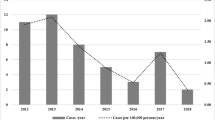Abstract
In the late 1996, an outbreak of botulism affected eight young people (age of patients ranged from 6 to 23 years) in Italy. The onset of the illness was the same for all of these patients: gastrointestinal symptoms (nausea and vomiting) followed by neurologic symptoms. The most common neurologic symptoms were dysphagia, respiratory failure (100%), diplopia (87%), dysarthria, ptosis (75%) and mydriasis (50%). All patients required mechanical ventilation. Botulinum toxin was detected from two of respectively five sera and six stool samples analysed, while spores of Clostridium botulinum type A were recovered from all patient' faeces. The epidemiological investigation led to suspect a commercial cream cheese (‘mascarpone’) as a source of botulinum toxin: indeed, it had been eaten by all the patients before onset of the symptoms, either alone or as the (uncooked) ingredient of a dessert, ‘tiramisù’. Botulinum toxin type A was found in the ‘tiramisù’ leftover consumed by two patients and in some mascarpone cheese samples collected from the same retail stores where the other patients had previously bought their cheeses. A break in the cold-chain at the retail has likely caused germination of C. botulinum spores contaminating the products, with subsequent production of the toxin. One of the patients died, while the others recovered very slowly. Prompt international alerting and recall of the mascarpone cheese prevented the spread of the outbreak due to the wide range of distribution, demonstrating the importance of a rapid surveillance system. None of the people complaining of symptoms after the public alert resulted positive for botulinum spores and toxin.
Similar content being viewed by others
References
Smith L, Sugiyama H. Botulism: The Organism, its Toxins, the Disease. Springfield: Charles C. Thomas, II. 1988.
Hatheway CL. Clostridium botulinum and other clostridia that produce botulinum neurotoxin. In: Haus-child AHW, Dodds KL (eds), Clostridium botulinum. Ecology and Control in Food. New York: Marcel Dekker, 1992; 3–20.
Meng X, Karasawa T, Zou K, et al. Characterization of a neurotoxigenic Clostridium butyricum strain isolated from the food implicated in an outbreak of food-borne type E botulism. J Clin Microbiol 1997; 35: 2160–2162.
Chaudhry R, Dhawan B, Kumar D, et al. Outbreak of suspected Clostridium butyricum botulism in India. EID 1998; 4: 506–507.
Aureli P, Fenicia L, Franciosa G. Classic and emergent forms of botulism: The current status in Italy. Euro-surveillance 1999; 4: 7–9.
Aureli P, Franciosa G, Pourshaban M. Foodborne botulism in Italy. Lancet 1996; 348: 1594.
Hatheway CL. Botulism. In: Balows A, Hausler WJ, Jr., Ohashi M, Turano A (eds), Laboratory Diagnosis of Infectious Diseases: Principles and Practice, vol 1. New York: Springer-Verlag, 1988; 111–133.
Kautter DA, Solomon HM, Lake DE, Bernard DT, Mills DC. Clostridium botulinum and its toxins. In: Vanderzant C, Splittstoesser DF (eds), Compendium of the Methods for the Microbiological Examination of Foods, 3rd edition, Washington: APHA, 1992; 605–621.
Woodroff BA, Griffin PM, McCroskey LM, et al. Clinical and laboratory comparison of botulism from toxin type A, B, and E in the United States, 1975–1988. J Infect Dis 1992; 166: 1281–1286.
Donadio JA, Gangarosa EJ, Faich GA. Diagnosis and treatment of botulism. J Infect Dis 1971; 124: 108–112.
Angaut-Petit D, Molgo J, Comella JX, Faille L, Tabti N. Terminal sprouting in mouse neuromuscular junctions poisoned with botulinum type A toxin: Morphological and electrophysiological features. Neuroscience 1990; 37: 799–808.
Mann JM, Martin S, Hoffman R, Marrazzo S. Patient recovery from type A botulism: Morbidity assessment following a large outbreak. Am J Public Health 1981; 71: 266–269.
Collins-Thompson DL, Wood DS. Control in dairy products. In: Hauschild AHW, Dodds KL (eds), Clostridium botulinum. Ecology and Control in Food, New York: Marcel Dekker, 1992; 261–277.
Skovgaard N. Facts and trends in microbial contamination of dairy products. International Dairy Federation Bulletin 1990; 250: 31–33. International Dairy Federation, Square Vergote 41,1040 Bruxelles, Belgium.
Franciosa G, Pourshaban M, Gianfranceschi M, et al. Clostridium botulinum spores and toxin in mascarpone cheese and other milk products. J Food Prot 1999; 62: 867–871.
WHO surveillance programme for control of food-borne infections and intoxications in Europe. Sixth Report 1990–1992. Schmidt K (ed.) Federal institute for health protection of consumers and veterinary medicine, Berlin 1995.
ter Steeg PF, Cuppers HGAM. Growth of proteolytic Clostridium botulinum in process cheese products: II. Predictive modeling. J Food Prot 1995; 58: 1100–1108.
ter Steeg PF, Cuppers HGAM, Hellemons JC, Rijke G. Growth of proteolytic Clostridium botulinum in process cheese products: I. Data acquisition for modeling the influence of pH, sodium chloride, emulsifying salts, fat dry basis, and temperature. J Food Prot 1995; 58: 1091–1099.
Author information
Authors and Affiliations
Rights and permissions
About this article
Cite this article
Aureli, P., Di Cunto, M., Maffei, A. et al. An outbreak in Italy of botulism associated with a dessert made with mascarpone cream cheese. Eur J Epidemiol 16, 913–918 (2000). https://doi.org/10.1023/A:1011002401014
Issue Date:
DOI: https://doi.org/10.1023/A:1011002401014




